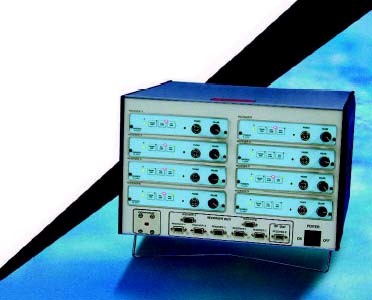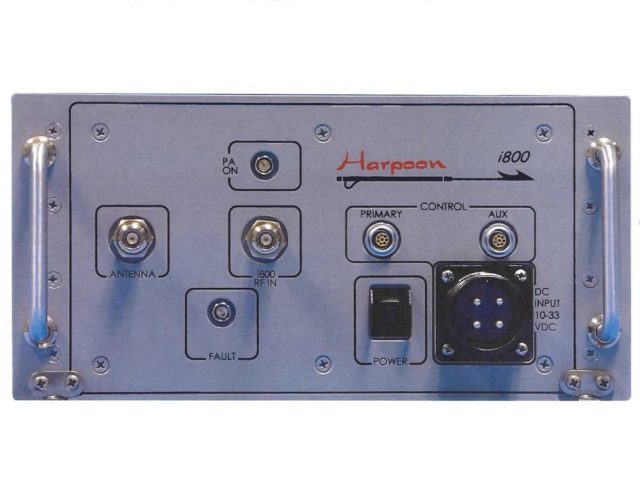OFF THE WIRE
Keeping tabs on civilian phones? There's more than one way to skin that cat.
by
The National Security Agency’s spying tactics are being intensely scrutinized following the recent leaks of secret documents. However, the NSA isn't the only US government agency using controversial surveillance methods.
Monitoring citizens' cell phones without their knowledge is a booming business. From Arizona to California, Florida to Texas, state and federal authorities have been quietly investing millions of dollars acquiring clandestine mobile phone surveillance equipment in the past decade.
Earlier this year, a covert tool called the “Stingray” that can gather data from hundreds of phones over targeted areas attracted international attention. Rights groups alleged that its use could be unlawful. But the same company that exclusively manufacturers the Stingray—Florida-based Harris Corporation—has for years been selling government agencies an entire range of secretive mobile phone surveillance technologies from a catalogue that it conceals from the public on national security grounds.
Details about the devices are not disclosed on the Harris website, and marketing materials come with a warning that anyone distributing them outside law enforcement agencies or telecom firms could be committing a crime punishable by up to five years in jail.
These little-known cousins of the Stingray cannot only track movements—they can also perform denial-of-service attacks on phones and intercept conversations. Since 2004, Harris has earned more than $40 million from spy technology contracts with city, state, and federal authorities in the US, according to procurement records.
In an effort to inform the debate around controversial covert government tactics, Ars has compiled a list of this equipment by scrutinizing publicly available purchasing contracts published on government websites and marketing materials obtained through equipment resellers. Disclosed, in some cases for the first time, are photographs of the Harris spy tools, their cost, names, capabilities, and the agencies known to have purchased them.
What follows is the most comprehensive picture to date of the mobile phone surveillance technology that has been deployed in the US over the past decade.
“Stingray”

The FBI uses the Stingray to track suspects and says that it does not use the tool to intercept the content of communications. However, this capability does exist. Procurement documents indicate that the Stingray can also be used with software called “FishHawk,” (PDF) which boosts the device’s capabilities by allowing authorities to eavesdrop on conversations. Other similar Harris software includes “Porpoise,” which is sold on a USB drive and is designed to be installed on a laptop and used in conjunction with transceivers—possibly including the Stingray—for surveillance of text messages.
Similar devices are sold by other government spy technology suppliers, but US authorities appear to use Harris equipment exclusively. They've awarded the company “sole source” contracts because its spy tools provide capabilities that authorities claim other companies do not offer. The Stingray has become so popular, in fact, that “Stingray” has become a generic name used informally to describe all kinds of IMSI catcher-style devices.
First used: Trademark records show that a registration for the Stingray was first filed in August 2001. Earlier versions of the technology—sometimes described as “digital analyzers” or “cell site simulators” by the FBI—were being deployed in the mid-1990s. An upgraded version of the Stingray, named the “Stingray II,” was introduced to the spy tech market by Harris Corp. between 2007 and 2008. Photographs filed with the US Patent and Trademark Office depict the Stingray II as a more sophisticated device, with many additional USB inputs and a switch for a “GPS antenna,” which is likely used to assist in location tracking.
Cost: $68,479 for the original Stingray; $134,952 for Stingray II.
“Gossamer”
The Gossamer is a small portable device that can be used to secretly gather data on mobile phones operating in a target area. It sends out a covert signal that tricks phones into handing over their unique codes—such as the IMSI and TMSI—which can be used to identify users and home in on specific devices of interest. What makes it different from the Stingray? Not only is the Gossamer much smaller, but it can also be used to perform a denial-of-service attack on phone users, blocking targeted people from making or receiving calls, according to marketing materials (PDF) published by a Brazilian reseller of the Harris equipment. The Gossamer has the appearance of a clunky-looking handheld transceiver. One photograph filed with the US Patent and Trademark Office shows it displaying an option for "mobile interrogation" on its small LCD screen, which sits above a telephone-style keypad.First used: Trademark records show that a registration for the Gossamer was first filed in October 2001.
Cost: $19,696.
Agencies: Between 2005 and 2009, the FBI, Special Operations Command, and Immigration and Customs Enforcement spent more than $1.3 million purchasing Harris’ Gossamer technology and upgrading existing Gossamer units, according to procurement records. Most of the $1.3 million was spent by the FBI as part of a large contract in 2005.
“Triggerfish”

First used: Trademark records show that a registration for the Triggerfish was filed in July 2001, though its “first use anywhere” is listed as November 1997. It is not clear whether the Triggerfish is still for sale or whether its name has recently changed, as the trademark on the device was canceled in 2008, and it does not appear on Harris’ current federal price lists.
Cost: Between $90,000 and $102,000.
Agencies: The Bureau of Alcohol, Tobacco, Firearms, and Explosives; the DEA; and county cops in Miami-Dade invested in Triggerfish technology prior to 2004, according to procurement records. However, the procurement records (PDF) also show that the Miami-Dade authorities complained that the device "provided access" only to Cingular and AT&T wireless network carriers. (This was before the two companies merged.) To remedy that, the force complemented the Triggerfish tool with additional Harris technology, including the Stingray and Amberjack, which enabled monitoring of Metro PCS, Sprint, and Verizon. This gave the cops "the ability to track approximately ninety percent of the wireless industry," the procurement documents state.
“Kingfish”

First used: Trademark records show that a registration for the Kingfish was filed in August 2001. Its “first use anywhere” is listed in records as December 2003.
Cost: $25,349.
Agencies: Government agencies have spent about $13 million on Kingfish technology since 2006, sometimes as part of what is described in procurement documents as a “vehicular package” deal that includes a Stingray. The US Marshals Service; Secret Service; Bureau of Alcohol, Tobacco, Firearms, and Explosives; Army; Air Force; state cops in Florida; county cops in Maricopa, Arizona; and Special Operations Command have all purchased a Kingfish in recent years.
“Amberjack”

First used: Trademark records show that a registration for the Amberjack was filed in August 2001 at the same time as the Stingray. Its “first use anywhere” is listed in records as October 2002.
Cost: $35,015
Agencies: The DEA; FBI; Special Operations Command; Secret Service; the Navy; the US Marshals Service; and cops in North Carolina, Florida, and Texas have all purchased Amberjack technology, according to procurement records.
“Harpoon”

First used: Trademark records show that a filing for the Harpoon was filed in June 2008.
Cost: $16,000 to $19,000.
Agencies: The DEA; state cops in Florida; city cops in Tempe, Arizona; the Army; and the Navy are among those to have purchased Harpoons since 2009.
“Hailstorm”
The Hailstorm is the latest in the line of mobile phone tracking tools that Harris Corp. is offering authorities. However, few details about it have trickled into the public domain. It can be purchased as a standalone unit or as an upgrade to the Stingray or Kingfish, which suggests that it has the same functionality as these devices but has been tweaked with new or more advanced capabilities. Procurement documents (PDF) show that Harris Corp. has, in at least one case, recommended that authorities use the Hailstorm in conjunction with software made by Nebraska-based surveillance company Pen-Link. The Pen-Link software appears to enable authorities deploying the Hailstorm to directly communicate with cell phone carriers over an Internet connection, possibly to help coordinate the surveillance of targeted individuals.First used: Unknown.
Cost: $169,602 as a standalone unit. The price is reduced when purchased as an upgrade.
Agencies: Public records show that earlier this year, the Baltimore Police Department, county cops in Oakland County, Michigan, and city cops in Phoenix, Arizona, each separately entered the procurement process to obtain the Hailstorm equipment. The Baltimore and Phoenix forces each set aside about $100,000 for the device, and they purchased it as an upgrade to Stingray II mobile phone spy technology. The Phoenix cops spent an additional $10,000 on Hailstorm training sessions conducted by Harris Corp. in Melbourne, Florida, and Oakland County authorities said they obtained a grant from the Department of Homeland Security to help finance the procurement of the Hailstorm tool. The Oakland authorities noted that the device was needed for “pinpoint tracking of criminal activity.” It is highly likely that other authorities—particularly federal agencies—will invest in the Hailstorm too, with procurement records eventually surfacing later this year or into 2014.
No one’s talking
Ars contacted the agencies most frequently referenced above, including the FBI; the DEA; the Bureau of Alcohol, Tobacco, Firearms, and Explosives; the Secret Service; and Immigration and Customs Enforcement. Our requests for comment were either not returned or rebuffed on the grounds that the topic is "law enforcement sensitive." Harris Corp. also turned down an interview request and declined to answer any questions for this story.The FBI has previously stated in response to questions about the Stingray device that it "strives to protect our country and its people using every available tool" and that location data in particular is a "vital component" of investigations. But when it comes to discussing specific surveillance equipment, it is common for the authorities to remain tight-lipped because they don’t want to reveal tactics to criminals.
The code of silence shrouding the above tools, however, is highly contentious. Their use by law enforcement agencies is in a legal gray zone, particularly because interference with communications signals is supposed to be prohibited under the federal Communications Act. In May, an Arizona court ruled that the FBI's use of a Stingray was lawful in a case involving conspiracy, wire fraud, and identity theft. But according to the American Civil Liberties Union (ACLU), when seeking authorization for the use of the Stingray tool, the feds have sometimes unlawfully withheld information from judges about the full scope of its capabilities. This means that judges across the country are potentially authorizing the use of the technology without even knowing what it actually does.
That's not all. There is another significant issue raised by the Harris spy devices: security. According to Christopher Soghoian, chief technologist at the ACLU, similar covert surveillance technology is being manufactured by a host of companies in other countries like China and Russia. He believes the US government’s “state secrecy” on the subject is putting Americans at risk.
"Our government is sitting on a security flaw that impacts every phone in the country," Soghoian says. "If we don't talk about Stingray-style tools and the flaws that they exploit, we can't defend ourselves against foreign governments and criminals using this equipment, too."




























































































































